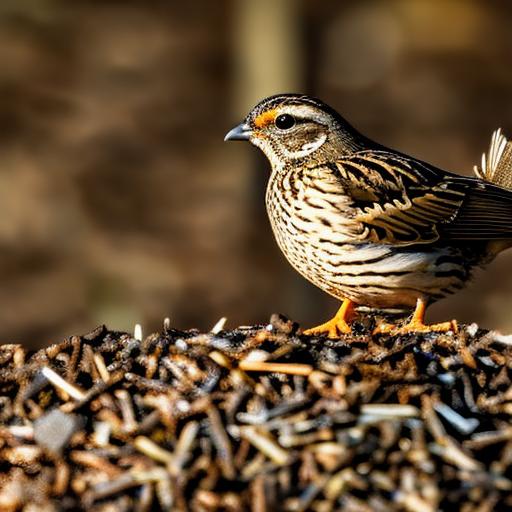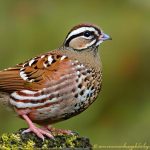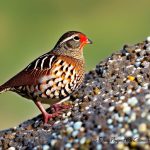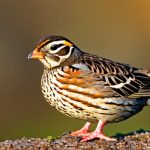Keeping quail on wood chips is a popular and effective method for creating a comfortable and healthy environment for these small birds. Wood chips provide a natural and absorbent bedding material that helps to maintain cleanliness and hygiene in the quail enclosure. This method is also beneficial for the quail’s well-being, as it allows them to exhibit natural behaviors such as scratching and dust bathing. In this article, we will explore the benefits of using wood chips for quail, how to choose the right type of wood chips, preparing the quail enclosure with wood chips, maintaining the quail enclosure, potential challenges and solutions, and final tips for keeping quail on wood chips.
Key Takeaways
- Keeping quail on wood chips is a natural and sustainable way to provide bedding and flooring for quail enclosures.
- Using wood chips for quail bedding can help control odor, absorb moisture, and provide a comfortable environment for the birds.
- When choosing wood chips for quail bedding, it’s important to select a type that is non-toxic, dust-free, and free from additives or chemicals.
- Preparing the quail enclosure with wood chips involves spreading a layer of chips on the floor, ensuring proper drainage, and providing additional nesting material.
- Maintaining the quail enclosure with wood chips requires regular cleaning, adding fresh chips as needed, and monitoring for any potential issues such as mold or pests.
Benefits of Using Wood Chips for Quail
There are numerous benefits to using wood chips for quail bedding. Firstly, wood chips are highly absorbent, which helps to keep the quail enclosure dry and free from moisture. This is important for preventing the growth of harmful bacteria and fungi, which can cause health issues for the quail. Additionally, wood chips provide a soft and comfortable surface for the quail to walk and rest on, which is essential for their overall well-being. Furthermore, wood chips are natural and non-toxic, making them a safe option for quail bedding. They also provide insulation, helping to regulate the temperature in the enclosure and keep the quail warm during colder months. Overall, using wood chips for quail bedding promotes a clean, comfortable, and healthy environment for these birds to thrive in.
Choosing the Right Type of Wood Chips
When choosing wood chips for quail bedding, it is important to select the right type of wood that is safe and suitable for the birds. Hardwood chips such as oak, maple, or beech are ideal choices, as they are non-toxic and provide good absorbency. Avoid using softwood chips such as pine or cedar, as they contain aromatic oils that can be harmful to quail and other small animals. It is also important to use untreated wood chips, as chemicals or preservatives used in treated wood can be toxic to quail. Additionally, ensure that the wood chips are finely shredded to provide a comfortable and uniform bedding surface for the quail. When sourcing wood chips, consider purchasing from reputable suppliers or ensuring that they are free from any contaminants or debris that could potentially harm the quail.
Preparing the Quail Enclosure with Wood Chips
Before adding wood chips to the quail enclosure, it is essential to prepare the area to ensure a clean and safe environment for the birds. Start by thoroughly cleaning the enclosure and removing any old bedding material or debris. This will help to prevent the build-up of bacteria and pests in the new bedding. Once the enclosure is clean, spread a layer of wood chips evenly across the floor to create a soft and absorbent bedding surface for the quail. The depth of the wood chip bedding should be around 2-3 inches, providing enough cushioning for the quail to walk and rest comfortably. It is also important to regularly monitor the condition of the wood chips and replace them when they become soiled or compacted. By properly preparing the quail enclosure with wood chips, you can ensure a comfortable and hygienic living space for your birds.
Maintaining the Quail Enclosure with Wood Chips
Maintaining the quail enclosure with wood chips is essential for promoting a clean and healthy environment for the birds. Regularly inspect the wood chip bedding for any signs of moisture, mold, or foul odors, as these can indicate an unhealthy living environment for the quail. Remove any soiled or wet wood chips and replace them with fresh bedding to maintain cleanliness and prevent the build-up of harmful bacteria. Additionally, regularly fluffing and turning the wood chips will help to aerate the bedding and prevent compaction, ensuring that it remains soft and comfortable for the quail. It is also important to regularly spot clean the enclosure by removing any droppings or debris from the wood chip bedding to maintain hygiene. By consistently maintaining the quail enclosure with wood chips, you can provide a clean and comfortable living space for your birds to thrive in.
Potential Challenges and Solutions
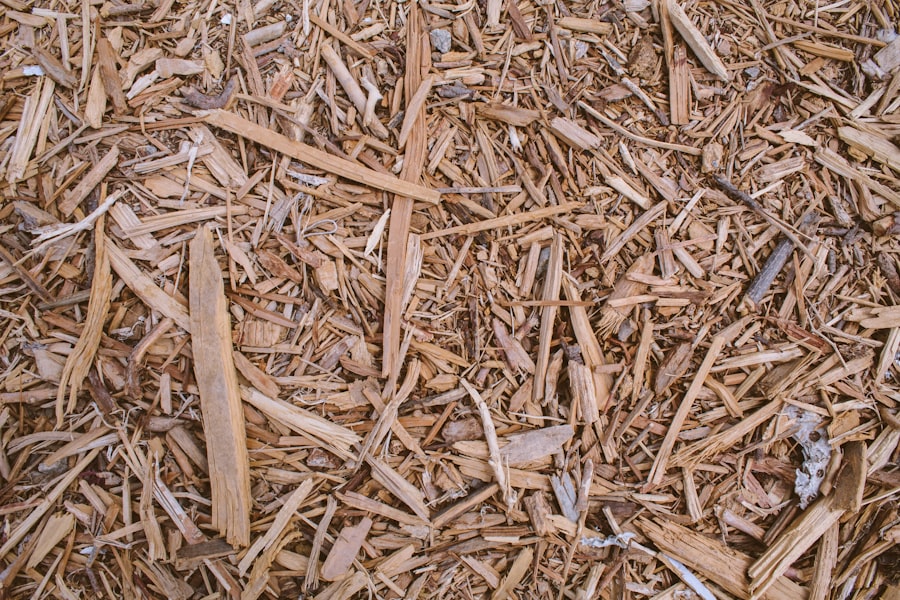
While keeping quail on wood chips can offer numerous benefits, there are also potential challenges that may arise. One common challenge is the build-up of ammonia from quail droppings, which can lead to respiratory issues for the birds if not properly managed. To address this challenge, regularly spot clean the wood chip bedding to remove droppings and replace soiled bedding with fresh material. Additionally, adding natural odor-absorbing materials such as dried herbs or activated charcoal to the wood chip bedding can help to reduce ammonia levels and maintain air quality in the enclosure. Another potential challenge is pest infestations such as mites or flies in the wood chip bedding. To prevent this, regularly inspect the bedding for signs of pests and treat any infestations promptly with natural pest control methods or seek advice from a veterinarian. By being proactive in addressing potential challenges, you can ensure a safe and healthy living environment for your quail on wood chips.
Conclusion and Final Tips for Keeping Quail on Wood Chips
In conclusion, keeping quail on wood chips offers numerous benefits for both the birds and their caregivers. Wood chips provide a natural, absorbent, and comfortable bedding material that promotes cleanliness, hygiene, and overall well-being for quail. When choosing wood chips for quail bedding, it is important to select non-toxic hardwood varieties that are finely shredded and free from contaminants. Properly preparing and maintaining the quail enclosure with wood chips is essential for creating a clean and healthy living environment for the birds. While there may be potential challenges such as ammonia build-up or pest infestations, proactive management and regular maintenance can help to address these issues effectively. By following these guidelines and tips, you can create a safe, comfortable, and natural living space for your quail on wood chips, allowing them to thrive and flourish in their environment.
If you’re considering using wood chips for your quail bedding, you may also be interested in learning about the incubation period for goose eggs. Understanding the incubation process is crucial for successful breeding and hatching. Check out this informative article on PoultryWizard to gain valuable insights into this aspect of poultry care.
FAQs
What are the benefits of using wood chips for keeping quail?
Wood chips provide a natural and comfortable bedding material for quail. They also help to absorb moisture and control odor in the quail enclosure.
What type of wood chips are safe for quail?
It is important to use untreated, non-toxic wood chips for quail bedding. Pine and aspen wood chips are commonly used and considered safe for quail.
How often should wood chips be changed in a quail enclosure?
Wood chips should be changed regularly to maintain a clean and healthy environment for the quail. Depending on the size of the enclosure and the number of quail, wood chips may need to be changed every 1-2 weeks.
Are there any potential drawbacks to using wood chips for quail bedding?
While wood chips can provide a comfortable and natural bedding material for quail, they can also pose a risk of mold growth if they become too damp. It is important to monitor the moisture levels and cleanliness of the wood chips regularly.
How should wood chips be prepared before using them for quail bedding?
Before using wood chips for quail bedding, they should be thoroughly dried to remove any excess moisture. It is also important to ensure that the wood chips are free from any contaminants or debris.
Meet Walter, the feathered-friend fanatic of Florida! Nestled in the sunshine state, Walter struts through life with his feathered companions, clucking his way to happiness. With a coop that’s fancier than a five-star hotel, he’s the Don Juan of the chicken world. When he’s not teaching his hens to do the cha-cha, you’ll find him in a heated debate with his prized rooster, Sir Clucks-a-Lot. Walter’s poultry passion is no yolk; he’s the sunny-side-up guy you never knew you needed in your flock of friends!

